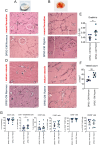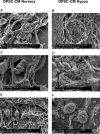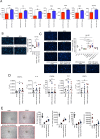Dental pulp mesenchymal stem cell (DPSCs)-derived soluble factors, produced under hypoxic conditions, support angiogenesis via endothelial cell activation and generation of M2-like macrophages
- PMID: 39491013
- PMCID: PMC11533415
- DOI: 10.1186/s12929-024-01087-6
Dental pulp mesenchymal stem cell (DPSCs)-derived soluble factors, produced under hypoxic conditions, support angiogenesis via endothelial cell activation and generation of M2-like macrophages
Abstract
Background: Cell therapy has emerged as a revolutionary tool to repair damaged tissues by restoration of an adequate vasculature. Dental Pulp stem cells (DPSC), due to their easy biological access, ex vivo properties, and ability to support angiogenesis have been largely explored in regenerative medicine.
Methods: Here, we tested the capability of Dental Pulp Stem Cell-Conditioned medium (DPSC-CM), produced in normoxic (DPSC-CM Normox) or hypoxic (DPSC-CM Hypox) conditions, to support angiogenesis via their soluble factors. CMs were characterized by a secretome protein array, then used for in vivo and in vitro experiments. In in vivo experiments, DPSC-CMs were associated to an Ultimatrix sponge and injected in nude mice. After excision, Ultimatrix were assayed by immunohistochemistry, electron microscopy and flow cytometry, to evaluate the presence of endothelial, stromal, and immune cells. For in vitro procedures, DPSC-CMs were used on human umbilical-vein endothelial cells (HUVECs), to test their effects on cell adhesion, migration, tube formation, and on their capability to recruit human CD14+ monocytes.
Results: We found that DPSC-CM Hypox exert stronger pro-angiogenic activities, compared with DPSC-CM Normox, by increasing the frequency of CD31+ endothelial cells, the number of vessels and hemoglobin content in the Ultimatrix sponges. We observed that Utimatrix sponges associated with DPSC-CM Hypox or DPSC-CM Normox shared similar capability to recruit CD45- stromal cells, CD45+ leukocytes, F4/80+ macrophages, CD80+ M1-macrophages and CD206+ M2-macropages. We also observed that DPSC-CM Hypox and DPSC-CM Normox have similar capabilities to support HUVEC adhesion, migration, induction of a pro-angiogenic gene signature and the generation of capillary-like structures, together with the ability to recruit human CD14+ monocytes.
Conclusions: Our results provide evidence that DPSCs-CM, produced under hypoxic conditions, can be proposed as a tool able to support angiogenesis via macrophage polarization, suggesting its use to overcome the issues and restrictions associated with the use of staminal cells.
Keywords: Angiogenesis; Cell-free device; Dental pulp stem cells; Macrophage polarization; Mesenchymal stem cells; Secretome; Tissue engineering.
© 2024. The Author(s).
Conflict of interest statement
The authors declare that they have no competing interests.
Figures






Similar articles
-
Activin a regulates vascular formation and stabilization in direct coculture of dental pulp stem cells and endothelial cells.Int Endod J. 2025 Jul;58(7):991-1005. doi: 10.1111/iej.14226. Epub 2025 Mar 19. Int Endod J. 2025. PMID: 40106315 Free PMC article.
-
Conditioned media from dental pulp stem cells improved diabetic polyneuropathy through anti-inflammatory, neuroprotective and angiogenic actions: Cell-free regenerative medicine for diabetic polyneuropathy.J Diabetes Investig. 2019 Sep;10(5):1199-1208. doi: 10.1111/jdi.13045. Epub 2019 Apr 23. J Diabetes Investig. 2019. PMID: 30892819 Free PMC article.
-
VEGFR2-dependent angiogenic capacity of pericyte-like dental pulp stem cells.J Dent Res. 2013 Jun;92(6):524-31. doi: 10.1177/0022034513485599. Epub 2013 Apr 22. J Dent Res. 2013. PMID: 23609159
-
Dental Pulp Stem Cell-Derived Conditioned Medium: An Attractive Alternative for Regenerative Therapy.Tissue Eng Part B Rev. 2019 Feb;25(1):78-88. doi: 10.1089/ten.TEB.2018.0168. Epub 2018 Oct 9. Tissue Eng Part B Rev. 2019. PMID: 30156475 Review.
-
Intrinsic and extrinsic modulators of human dental pulp stem cells: advancing strategies for tissue engineering applications.Mol Biol Rep. 2025 Feb 3;52(1):190. doi: 10.1007/s11033-025-10281-0. Mol Biol Rep. 2025. PMID: 39899148 Review.
Cited by
-
Molecular Biological Comparison of Pulp Stem Cells from Supernumerary Teeth, Permanent Teeth, and Deciduous Teeth for Endodontic Regeneration.Int J Mol Sci. 2025 Feb 24;26(5):1933. doi: 10.3390/ijms26051933. Int J Mol Sci. 2025. PMID: 40076559 Free PMC article.
-
The Effect of Conditioned Medium from Angiopoietin-1 Gene-Modified Mesenchymal Stem Cells on Wound Healing in a Diabetic Mouse Model.Bioengineering (Basel). 2024 Dec 9;11(12):1244. doi: 10.3390/bioengineering11121244. Bioengineering (Basel). 2024. PMID: 39768062 Free PMC article.
-
Application of dental pulp stem cell-conditioned medium combined with deep cryopreservation of autologous cranial flaps.Stem Cell Res Ther. 2025 Jun 2;16(1):272. doi: 10.1186/s13287-025-04407-1. Stem Cell Res Ther. 2025. PMID: 40457321 Free PMC article.
-
Crosstalk Between H-Type Vascular Endothelial Cells and Macrophages: A Potential Regulator of Bone Homeostasis.J Inflamm Res. 2025 Feb 25;18:2743-2765. doi: 10.2147/JIR.S502604. eCollection 2025. J Inflamm Res. 2025. PMID: 40026304 Free PMC article. Review.
References
-
- Minton K. Connecting angiogenesis and autoimmunity. Nat Rev Immunol. 2019;19(10):596–7. - PubMed
-
- Frantz S, Vincent KA, Feron O, Kelly RA. Innate immunity and angiogenesis. Circ Res. 2005;96(1):15–26. - PubMed
-
- Varricchi G, Loffredo S, Galdiero MR, Marone G, Cristinziano L, Granata F, et al. Innate effector cells in angiogenesis and lymphangiogenesis. Curr Opin Immunol. 2018;53:152–60. - PubMed
MeSH terms
Substances
LinkOut - more resources
Full Text Sources
Research Materials
Miscellaneous

